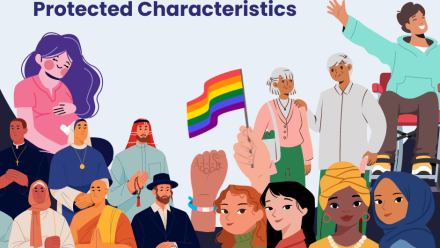Which leadership styles help foster diversity and inclusion?
16th August 2021 by Ellie Thompson
Your leadership style doesn’t just dictate how you lead your team. It also has a direct impact on how diverse and inclusive your organisation is. Some leadership styles may end up undermining and conflicting with your diversity and inclusion measures. But, with the right leadership style, you’ll naturally foster a workplace that feels inclusive for all.
You can work out what leadership style will suit you, your organisation, and your goals for diversity and inclusion, by answering some of the following questions.
What are leadership styles?
Understanding different leadership styles (Goleman)
Goleman’s leadership styles theory outlines 6 different styles, as follows:
1) Pacesetting style: focuses on expecting peak performance and results
2) Coaching style: dedicated to developing team members
3) Democratic style: where everyone is involved in team decisions and consensus is key
4) Affiliative style: prioritises wellbeing and encourages building nurturing relationships
5) Visionary style:inspires the team towards a long-term vision
6) Commanding style: all about telling people exactly what to do
Which of the different leadership styles best foster diversity and inclusion?
Clearly Goleman’s leadership styles are diverse, ranging from leadership styles autocratic in nature- such as the commanding style, which expects absolute full potential and peak performance from your team- to those that prioritise nurturing- such as a coaching style, dedicated to developing your team members.
However, Goleman makes it clear that there isn’t one ‘good’ leadership style; instead, a good leader will use their emotional intelligence and empathy to strategically use the best leadership style for the team at any given moment.
So the most inclusive style is actually a patchwork of different approaches that focus on responding to the needs and obligations of the team, and recognise that there’s no single right answer.
This is even more important when we consider how to welcome diversity within your team. You should always ensure that you’re leading in a neuroinclusive way. That means recognising and welcoming the diversity of thought within your organisation and creating space for everyone to work in the way that suits them best. You’ll find that different people respond differently to leadership styles in management. For example, some neurodiverse employees will work best under a commanding style which allows for ultimate clarity about roles, responsibilities, and objectives. For others, it’s vital to create a wellbeing-focused space wherein they’ll feel most nurtured and enabled to reach their full potential.
It can take some time to develop a full understanding of each leadership style, how to use them, and which will work best for your team and the people within it. Consider leadership styles coaching, especially coaching and consultancy from an organisation like Diversity and Ability that prioritises inclusion and celebrates diversity.

How should I communicate with my team?
Communication style and leadership styles go hand in hand. The way you choose to communicate with your team shows them what you value and prioritise, and what success looks like for you. For example, if you’re a leader who makes time for regular communication with your team and offers plenty of space for feedback and ideas, you’re probably using more democratic leadership styles. If your communications tend to focus on setting objectives and monitoring key performance indicators, you’re demonstrating a Pacesetting leadership style.
And just as it’s important to switch up your leadership to match the style and access needs of your team, it’s equally vital you employ diverse communication methods to ensure everyone can engage and be heard.
This is an absolute must in creating a diverse and inclusive workplace. Often our organisations can be stuck in one way of thinking and communicating, but this fails to reflect the diversity of thought and experiences we want to see in our team.
Consider how you can:
1) Make use of different communication channels. Some people will prefer synchronous communication, such as meetings or phone calls, and others will prefer asynchronous, like messaging platforms or emails. Some will flourish in a group setting; others work best one-to-one. If you can work with your team to find out the ways they communicate best, you’ll be rewarded with new input and ideas.
2) Create space to receive feedback. Giving your employees a way to share their thoughts on your leadership styles, and your organisation, tells them they are truly valued. Fostering this sense of value and welcoming honest feedback leads to employees who feel safe and celebrated at work, and helps you establish how the differences in leadership styles are received by your team.
3) Avoid hierarchy. Decisions will be most inclusive if they come from a diverse range of people within your organisation. When you’re open about upcoming decisions within the business, you’re not just demonstrating that you value the participation of your employees; you’re also making space to benefit from their insight into how to ensure those decisions welcome diversity and foster inclusion.
How can I be a Diversity and Inclusion leader?
Your employees won’t commit to diversity and inclusion unless they see that you’re doing the same. Make sure you’re practicing what you preach and showing your employees just how committed your organisation is to diversity and inclusion.
“If you, as a leader, make inclusion a priority, that will make it a priority for the whole workforce,” says Adam, Co-founding Director at Diversity and Ability, “A shared group priority turns in to an organisation-wide value, and having inclusion as a value creates an inclusive workplace culture in which everyone can thrive.”
So, how can you make this happen?
Welcome honesty around mistake-making.
Foster radical transparency within your organisation. What we mean by this is not to cover up bad news or hide past bad practice. It’s rare for organisations to put their hands up and admit what they could be doing better, what they need to learn, and how they’re going to make this happen. But doing so means you’re seen as authentic, and that employees and customers know they can be taken with you on the journey towards better practice. And modelling this level of transparency means your employees will follow suit, creating an open and honest environment where people can learn and thrive.
Stay actively involved in D&I work
Don’t just set up Employee Resource Groups and consider the job done. You need to ensure you’re always thinking about, and talking about, diversity and inclusion. Don’t just arrange workshops and training programmes that encourage inclusion and dismantle barriers; attend them. Show your employees how diversity and inclusion is central to your business’s culture, processes, and success.
Rethink hierarchies
Often in diversity and inclusion, you’ll hear people refer to individuals or communities as ‘hard to reach’. But instead, you should be asking: who is easy to ignore? You may find that your organisational structures- especially hierarchies- create space for the same people to share their thoughts. But for diversity and inclusion to have meaning, you need to include everyone, from all spheres and sectors of your organisation. Work out whose voices aren’t being heard and find a way to welcome them. The responsibility is on you to reach out, not on others to come to you.
Be an upstander
Remember that, at its core, diversity and inclusion isn’t about successful business tactics or a good reputation. It’s about a moral imperative to make the world fair, equitable and accessible for all. So, create a true commitment to diversity and inclusion and be an upstander not just for your workplace, but in all aspects of your life. Be actively anti-discrimination and implore others to follow suit. Make sure the organisations you work with are meeting your high standards for diversity and inclusion. Pull people, and businesses, up when they’re falling short. Because those who take on inclusion as a genuine commitment are the ones who lead the way for real change.


